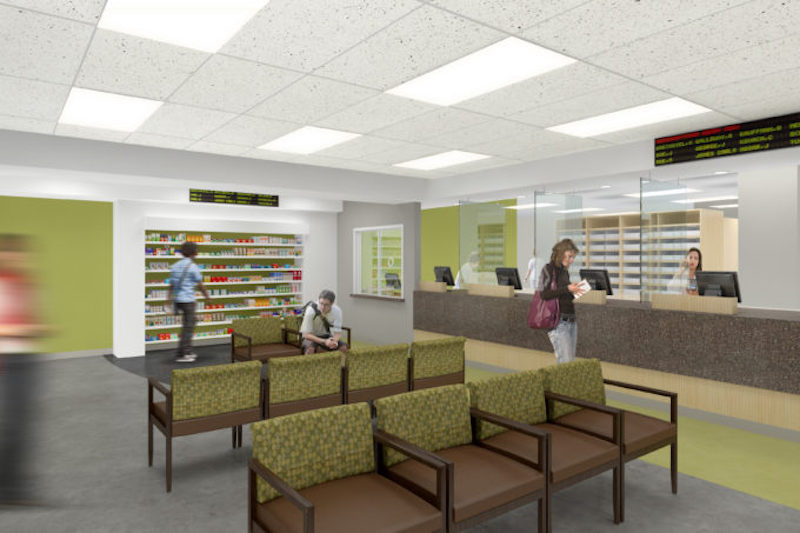Maintaining the sterility of a space where pharmaceuticals are prepared protects healthcare personnel, patients, and the environment. That’s why the Food and Drug Administration (FDA), state boards of pharmacy and accrediting agencies such as the Joint Commission and the Pharmacy Compounding Accreditation Board began enforcing guidelines addressing the risks several years ago.
Released in February 2016, the latest standards of the United States Pharmacopeia’s (USP’s) Chapter 800 Pharmaceutical Compounding—Sterile Preparations (commonly known as USP 800) builds on earlier regulations set forth by USP 797 and places stringent new standards for handling hazardous drugs on hospitals already burdened by increased regulatory pressures. Challenging? Yes. But with appropriate planning and a knowledgeable healthcare design team, health facilities managers can achieve compliance.
What is USP 800?
The USP is a scientific, non-profit organization that sets recognized national standards for identity, strength, quality, and purity of drugs. USP 800 is a set of guidelines, procedures and compliance requirements for compounding sterile preparations (CSPs). Overseen by the FDA, USP 800 sets federally enforceable legal standards to help increase awareness, provide uniform guidance to reduce the risk of managing hazardous drugs, and to help reduce the risk posed to patients and healthcare staff. The regulations also address the problem of ensuring that board regulations are aligned with compounding standards of USP 797 and 800, which further ensures the safety of consumers receiving compounded drugs in California. USP 800 offers specifications for the built environment, including engineering controls. The national standard will become effective in December 2019, and many pharmacies in the U.S. will need to modify their spaces prior to that date to meet these new guidelines.
Facility implications
The new guidelines set specific requirements for engineering and environmental quality and control at all hospital facilities. Those facilities not currently meeting the subject regulations covered in the guidelines will require physical construction or alteration to a hospital building or its physical environment. Beyond updating processes and procedures, hospitals will be required to improve or reconfigure facilities for ventilation, install new equipment for sterility, and ensure employee protections. Perhaps the greatest challenge to hospitals is budgeting funds to achieve compliance with USP 800. Regardless of the obstacles, the new regulations impose a clearly defined timeframe by which hospitals must achieve compliance, intensifying the pressure to take immediate action and secure the financial resources needed.
Design expertise
Because agencies are still very unclear and inconsistent on how to approve these new design requirements, HMC Architects took the necessary action to become experts very quickly—or else risk getting bogged down in plan check failure that could hurt our clients and waste time. To provide them the best possible service, we are conducting research, sharing information, and developing best practices in real time to establish standards. These include templates, agency back check comments, owner comments and experience, and floor plan solutions. Critical to developing the appropriate solutions for our clients, our teams created single-point document repositories of the most current solutions approved by owners and agencies. Getting economy of scale has allowed us to become specialists and make these projects a financial success for everyone.

Design tactics
To be compliant, we need to consider current space constraints, cost, continued operations during retro fits, mechanical and electrical impacts, ventilation and climate control. Because this is a new process, a successful implementation requires collaboration, coordination, and a focused approach. At HMC, we have 24 specialists throughout our nine offices who are engaged in weekly calls to review experiences with client coordination, agency feedback, and documenting best practices. This allows us to collaborate on the design, planning, approval, and construction of the 18 to 20 compounding pharmacy projects on which we’re currently working. Sharing the latest information from approving agencies – along with best practices for design – helps us ensure these projects are approved as fast as possible and providing our clients with consistent reliability.
Action steps
The national standard becomes active in December 2019. There is opportunity to take action. The following measures can help to make a healthcare facility compliant with USP 800:
Designate a project design team as soon as possible.
– Put together an experienced team early in the evaluation process that includes an owner representative, pharmacist, architect, mechanical, electrical, and plumbing (MEP) engineers, security consultant, equipment specialist, contractor, and cost estimator to establish a realistic project budget.
Plan for temporary licensed facilities from day one.
– If in California, get California Department of Public Health (CDPH) approval via the Office of Statewide Health Planning and Development (OSHPD) of the functional program during the OSHPD preliminary review. This will save time and OSHPD will require it.
– Establish a realistic project timeline that includes construction and licensing of temporary facilities. We recommend that the contractor is engaged as early as possible, during the evaluation of existing facilities.
– Have the project design team evaluate your existing facilities and provide a written report of what is needed to achieve compliance with USP 797/800. Most importantly, prepare a timeline outlining the next steps and durations. While December 2019 seems far away, it’s a quick timeframe for phased construction and projects requiring OSHPD approval.
– Evaluate existing conditions and desired equipment. Cut sheets should be provided as early as possible.
– Owner should prepare “As-Built” documents and make available to the project design team as early as possible. Electrical panel readings and air-balance reports are critical during the design development phase.
Meet and communicate weekly.
– Invite the OSHPD inspector to your weekly project team meetings. Regular communication is the key to success.
– Include OSHPD reviewers in the communication as early as possible. For OSHPD projects, plan for preliminary OSHPD reviews. This is money well spent, especially if you are attempting to “fast track” your project.
– Suggest submitting 50 percent of your construction documents for preliminary review. Be flexible and prepare to make changes as requested.
– Design and plan for a “worst-case scenario.” Having a best- and worst-case timeline allows the client to plan accordingly either way.
Discuss project timelines frequently with the project team. Construction duration of six months (especially during flu season) is recommended. Evaluation is necessary to understand the pathway to upgrade your existing facility. This process may differ for OSHPD vs. non-OSHPD facilities. But, the earlier the client is aware of the pathway to compliance, the more cost-effective the decisions.
More from Author
HMC Architects | May 30, 2024
Inclusive design strategies to transform learning spaces
Students with disabilities and those experiencing mental health and behavioral conditions represent a group of the most vulnerable students at risk for failing to connect educationally and socially. Educators and school districts are struggling to accommodate all of these nuanced and, at times, overlapping conditions.
HMC Architects | Apr 29, 2024
Tomorrow's classrooms: Designing schools for the digital age
In a world where technology’s rapid pace has reshaped how we live, work, and communicate, it should be no surprise that it’s also changing the PreK-12 education landscape.
HMC Architects | Mar 26, 2024
Safeguarding our schools: Strategies to protect students and keep campuses safe
HMC Architects' PreK-12 Principal in Charge, Sherry Sajadpour, shares insights from school security experts and advisors on PreK-12 design strategies.
HMC Architects | Jul 26, 2023
10 ways public aquatic centers and recreation centers benefit community health
A new report from HMC Architects explores the critical role aquatic centers and recreation centers play in society and how they can make a lasting, positive impact on the people they serve.
HMC Architects | Jul 25, 2023
The latest 'five in focus' healthcare interior design trends
HMC Architects’ Five in Focus blog series explores the latest trends, ideas, and innovations shaping the future of healthcare design.
HMC Architects | Jun 26, 2023
Addition by subtraction: The value of open space on higher education campuses
Creating a meaningful academic and student life experience on university and college campuses does not always mean adding a new building. A new or resurrected campus quad, recreational fields, gardens, and other greenspaces can tie a campus together, writes Sean Rosebrugh, AIA, LEED AP, HMC Architects' Higher Education Practice Leader.
HMC Architects | Apr 13, 2023
Creating a sense of place with multipurpose K-12 school buildings
Multipurpose buildings serve multiple program and functional requirements. The issue with many of these spaces is that they tend not to do any one thing well.
HMC Architects | Jun 2, 2022
Women in Architecture: How HMC Pioneers Gender Equality
A survey by the Association of Collegiate Schools of Architecture (ACSA) shows that while women account for nearly half of graduates from architecture programs, they only make up about 15 percent of licensed architects.
HMC Architects | Jan 20, 2020
Robotics in architecture and construction: An industry shift
Architects who embrace this intriguing and dynamic technology now will be better equipped to design the most efficient buildings of the future.
















